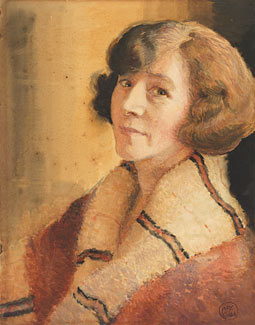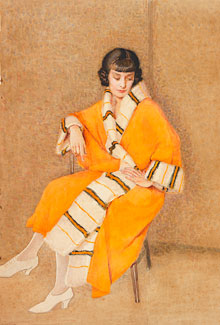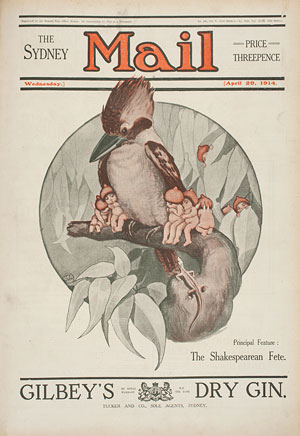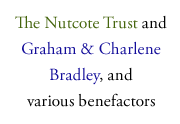Commercial art
In early 1913, May Gibbs returned to Australia with her close friend Irene (Rene) Heames, who she had met in London through the Women’s Suffrage movement. Soon after, the women moved from Perth to Sydney.
At 36 years of age, May was ready to make her mark and quickly set to work in her 'Little Studio’, at 4 Bridge Street, while Rene took a job as a telephonist at the GPO. The women shared boarding rooms in Neutral Bay, and Rene also helped May handcraft a range of calendars and cards using her Australian themes. This pair of portraits, painted by May in about 1923, shows both women wearing the same terry cloth beach robe.
In December 1913, May Gibbs took out copyright registration for a gumleaf-shaped bookmark which would become one of Australia’s most iconic designs. She wanted to design a good Australian bookmark and thought the gumleaf ‘a pretty thing’, if only she could ‘make it interesting [on] both sides’. It was from this simple bookmark design that her entire bushland fantasy world would evolve.
The first gumnut baby bookmarks were hand-painted by May and Rene and sold for five shillings each. But instant demand meant hand-production soon gave way to commercial print runs of the bookmarks which were then sold for only sixpence each.
Sydney was the place for an aspiring Australian illustrator at this time – with the offices of the most popular magazines, like The Bulletin and The Lone Hand, and publisher/bookseller Angus & Robertson all based there.
In mid 1913, the editor of The Sydney Mail offered May the chance to design 25 covers – the most substantial contract she had yet received. Between August 1913 and 17 June 1914, eight of Gibbs’ cover designs for The Sydney Mail were published, before this lucrative contract was curtailed by the outbreak of World War I.
In addition to this, during 1913 May also received a cover artist’s most sought after local commission, when Frank Fox, editor of The Lone Hand magazine, requested a Western Australian black swan cover design from her. The first of Gibb’s three published covers for The Lone Hand appeared in January 1914, featuring 13 gumnut babies nestled in a mass of gumleaves.
>View all May Gibbs' published cover designs for The Sydney Mail and related art work
>View an array of May Gibbs' cover designs for The Lone Hand and related art work
With the onset of World War I, May was anxious to contribute to the war effort. In all, May created over 30 designs for postcards during the war years. She later recalled: ‘I did the Gumnut cards because I wanted to do something for people to send to the soldiers…’. These cards were also included in the Red Cross parcels sent to Australian troops.
Her first series of postcards used some of her most popular designs: the Flannel Flower babies were registered in January 1914, followed by Christmas Bell babies in September. May’s distinctive designs also appeared on two further series of postcards featuring images of kookaburras and kangaroos and carrying characteristically Australian sentiments.
>See a selection of May Gibbs' World War I postcard designs
In 1920 May Gibbs received one of the most important commissions of her career. For this job she produced her largest artistic work and, arguably, her most celebrated and recognisable image.
The 'Dr Stork and Mrs Kookaburra' poster was an immediate success and the popularity of this image did not end there. In 1931, when the Public Health Department issued Our Babies, its first handbook for mothers, this iconic image was used as the cover illustration and remained in use until 1959.
>Find out more about May Gibbs' iconic poster design for this important public health campaign










